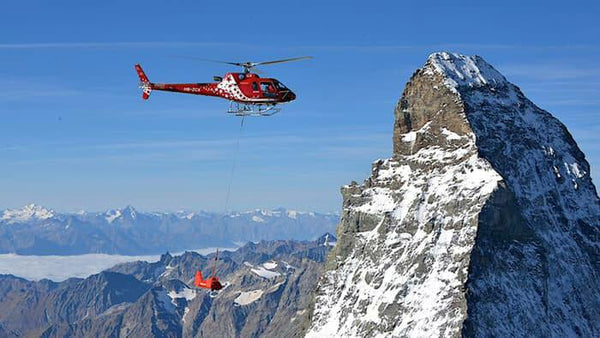Hunting & Wilderness Survival
Jan 11, 2023
Updated 1/11/2023
Wilderness Survival
They say what doesn't kill you makes you stronger. Consequently, a few of the scores of hunter's who go each year afield don't get a second chance to learn from their mistakes. The bones of hunters, gathers, mountain men, and explorers across the ages are strewn across the rugged mountains of North America and stand as a monument to the unforgiving nature of these big beautiful and dangerous mountains. The mountains beckon hunters each fall as the big game hunting seasons get underway. Most of the western states have posted big game draw results by now, and with anticipation and excitement, hunters are beginning to plan and prepare. As preparation for those mountain hunts begins, I urge hunters to consider taking precautions, having a plan "B," constructing a survival kit, and finally making high-quality performance clothing an integral part of your gear. Before we delve into a discussion on survival, let's consider some of the leading causes of death or serious injury among hunters: cardiac issues, falling, knife wounds, exposure to the elements to name a few. Without exception, all of these incidents can be avoided with proper planning, preparation, and quality equipment. This article is not an attempt to cover every corner of wilderness survival, but provide a few tips I hope will give you the confidence to tackle the rugged, unforgiving country of the Rocky Mountain West.
For more insight on wilderness survival, check out our interview with Roland Welker from History Channel's "Alone".
Mountain Shape
If you have a history of heart disease, let common sense prevail and get a medical exam before leaving on a hunt. Most will ignore this caution, and some will pay for it with their life. If you live at sea level and you are going to be hunting at 10k feet, it's an excellent idea to make sure your heart and lungs are up to the task of tackling the thin air. It might just save your life. In the age of mountain athletes, being mountain fit has never been more in style. Two decades ago, you would be hard-pressed to find a hunting article with tips and instructions on becoming a miniature version of a UFC fighter. As I write this article, almost every hunting magazine has dedicated pages to fitness. While I don't personally subscribe to this style of fitness, there is something to be said about being in shape for a mountain style hunt. The best way to prepare for a mountain hunt is to get some weight in your pack and start climbing hills. Yes, it's that simple. I'm not going to write a two-page article on lifting weights and cardio. Those topics have been covered in detail. If climbing hills are not an option, strap on a pack with some weight in it, adjust your treadmill to the steepest incline, and then walk at a moderate pace increasing your weight and pace each week. I work up to 50lbs. For those flat landers with no hill options, pack weight around the block and move out at a fast pace. These workouts provide exceptional cardio and strengthen the muscles you will be using for mountain travel. I have yet to find a better way of preparing your body for mountain abuse. Chopping 2 cords of firewood a day are right up there.
Having a Plan B
In 2011, I fulfilled a lifelong dream of hunting Alaska. A friend and I booked a combo hunt for Dall Sheep, Moose, and Grizzly. We were flown deep into the Alaskan wilderness. Our hunt was to be 14 days which ended up extending into 18 days due to weather. Over the course of those 18 days, we were fortunate to harvest a pair of nice rams, two giant bull moose, and a grizzly. To say we did a lot of butchering would be grossly understated. After putting my first Dall sheep on the ground, we went right to work butchering and skinning. While taking care of my sheep, I had a few close calls with my knife. I remember thinking to my self, "I'm out here hundreds of miles from nowhere. If I were to cut myself severely, I would be in serious trouble." With that thought in mind, I slowed down and focused on where my blade was about my fingers and limbs. Unfortunately, accidents happen, which is why you need a plan B. Most cuts can be dealt with, with bandages and tape, however, if you were to hit a major artery you would lose blood fast if pressure is not applied immediately. This is where, preparation, a basic knowledge of first aid and tourniquets will determine the outcome of life or death situation. Having a Plan B is more than having a box of Band-Aids in your pack. You must have the ability to contact the real world. If you are a long distance from a medical facility, you better have a way of calling for help. In the age of technology, there is no excuse for not having a device to call for help, and I'm not talking about a cell phone which will most likely be useless in wilderness areas. I'm talking about a Satellite phone, spot messenger, or many of the other devices that acquire reception via satellites. I realize it's neither practical or realistic for most hunters to own a satellite phone let alone afford a yearly service plan. However, many companies will rent you a satellite phone for a hunt at a nominal price. You can also purchase spot messenger device and service for a few hundred bucks. These are nifty little devices that are packed with usable features that could very well save your life. Best of all, they are affordable to the average hunter. On our Alaskan adventure, we had a Sat phone. While we did not have to use it to call for help, it gave me peace of mind and the confidence I needed to have a successful and enjoyable hunt.
Surviving the Elements
Many a mountain hunter has stepped into the wilderness never to be seen again. I suspect many of these poor souls became lost, panicked, and eventually succumbed to the elements. Some of the recovered bodies have been discovered to have in their possession the basic equipment needed to survive a few nights in the wilderness. One might ask, "why did they perish?" What happened? Being lost is a very helpless feeling. It's human nature to panic when we feel helpless. If you ever find yourself lost, realize your greatest asset is your head. You need to be calm so you can think clearly and objectively. Water and food are the least of your worries. Even in the middle of summer, the temperature and weather in the mountains can fluctuate drastically. You need to find shelter or construct a shelter. If you can survive the elements, the chances are good that you can survive long enough to be rescued. Whether I'm hunting from my truck with a day pack, or on a wilderness backpack hunt, I always carry a small survival kit. I know a lot of hunters who will not pack the extra weight of survival items. This is a big mistake. My survival kit is a little larger than a deck of poker cards. I use a waterproof plastic container to hold all my items. The total kit weighs no more than 6 ounces and contains a fire starter with tinder quick, lighter, small knife, mini light, parachute cord, needle and thread, a mini roll of duct tape. Also, I carry a little first aid kit with 4x4 gauze bandages, aspirin, disinfectant wipes, medical tape, and a small selection of band aides. I also bring a thermal blanket that weights just a few ounces and takes up virtually no room in my pack. The bulk of my items are for protection against the elements and staying warm and dry. If the elements permit, building a fire is one of the best things you can do if you become lost or injured in the mountains. A fire provides not only warmth, but also provides an element of security, safety, and is an excellent location device. I'm not a big fan of matches. They are easily damaged, and once ignited the flame is short lived. Matches also perform poorly in rainy and windy conditions.
No Matches in My Survival Kit
You will never find matches in my survival kit. There are dozens of better and more reliable ways to start a fire. A good old bic lighter is a fair choice but it to can have mechanical and fuel failures and can be useless if it becomes submerged in water. I usually carry a lighter as a backup fire starter. There are 100's of fire starter kits and devices to choose from and they all work to some degree; however, I have found the Spark-Lite Tinder Quick Aviation Fire Starter Kit (See Figure 2 below) to be a cut above the rest. Yea I know, that's a pretty big name for such a small kit. The kit comes in a small plastic box that measures about 2 inches tall and 1.5 inches wide and about a 1/2 inch deep. The whole kit weighs less than 2 ounces. Inside the box is a small plastic shaft with a spark wheel at the top that will produce 2000 quality hot sparks and is designed for one-handed operation. Also included in the box is eight tinder quick tabs. Starting a fire is as simple as pulling a waterproof Tinder-Quik Tab from the plastic case, fluff up the end by pulling it apart to form a puffy little cloud, and igniting it with the Spark-Lite Fire Starter. It's scary how fast you can ignite a tab with one spark. The result is a flame that will burn for 2 to 3 minutes giving you plenty of time to ignite your kindling. It is also important to note that after submerging a tinder quick tab in water, I wrung it out like a wet shirt and it still ignited with a couple of sparks. The Spark-Lite was designed explicitly for Aviation Survival Kits and is the official U.S. Military fire starter. It has frequently received praise from independent reviewers and military personnel. Best of all they are only $8.95.
Lost In The Mountains
I've only been lost once, but I have been turned around on more than one occasion. The one time I became lost was out of pure stupidity. I was young, dumb and bulletproof. I was exploring some new country I wanted to hunt. Seeing a canyon that looked promising, I threw caution to the wind and dove off into the thick timber and headed towards the bottom. Once at the bottom, I became turned around and began walking in the wrong direction. To make matters worse, the only thing I had on me were the clothes on my back which consisted of a cotton tee shirt and a pair of Jeans. Dark clouds began to gather, and I knew if I didn't make it back to my vehicle, things were going to go from bad to worse. I admit, my youthful judgment kicked in, and I started to panic. I began quickly covering ground in multiple directions. I soon realized how unproductive this was. I decided I better gathered my wits, settle down and think things through. I realized my the best option was to slow down and methodically try and retrace my steps. As I followed this course of action, it wasn't long before I was back at camp warming myself by the fire after being soaked to the bone by an all-out down poor. I vowed to never put myself in a helplessly lost predicament again. Shortly after this incident, I acquired my first GPS, and I have never looked back. There are multiple GPS offerings with Garmin and Magellan having the largest consumer selections.
The most important feature on a GPS is the ability to mark or save a location and then retrieve the saved coordinates at a later time. Every GPS that I'm aware of offers this feature and 100's of waypoints can be saved for future retrieval. Another awesome feature is tracking. If your GPS has a tracking feature, you will have the ability to examine your tracks about your current position, camp or vehicle. This feature comes in very handy when you are making your way back to camp in the dark. Another feature I use is the sunrise and sunset tables which allows me to see how much hunting light I have, or put a plan together for my morning hunt which usually involves significant travel in the dark.
Compatible GPS
Most GPS's are compatible with mapping software which allows you to create a route on your map and download it to your GPS for use in the field. Many of the current models come with topographical mapping software already installed. This allows you to see where you are about roads, trails, springs, lakes, etc. Some of the feature-rich models have a micro SD card slot where you can download specific maps that show where you are at in relation to private land. This is an invaluable tool for hunters who hunt near private property. I mentioned earlier in this article that I have been turned around a time or two. In these instances, I was returning to my vehicle or camp in the dark, after a long days hunt and lost my bearings. Thankfully, I had my GPS to get me back on track. As feature-rich as today's GPS's are, they are not infallible. Operation and function are dependent on batteries and satellite reception. If either fails, the unit becomes useless. A good plan "B" is to carry extra batteries, a compass, and map of the area you are hunting. A few years ago, a friend of mine told me of a giant buck that lived in a high lonely basin above timberline. When I pulled out a map of the basin, I soon realized why this buck reached the age of maturity. There were no foot trails into the basin. I realized I would have to navigate two miles of thick timber and deadfall to access the basin. I planned and made sure I threw in my pack a reliable compass and map. It's a good thing I did. My GPS lost reception shortly after I entered the timber. I fished the map and compass out of my pack, charted a course, and a few hours later was glassing for the giant buck that called this trail-less high lonesome basin home. I could have never found the basin and then returned safely back to my truck without the compass and map. While I use my GPS for 90% of my mountain navigation, it's imperative to have a plan B that is reliable.
Dress for Survival
It's been said a hundred times, but if it saves one life, I will say it again. Cotton apparel has no place in the mountains. While cotton is very comfortable as casual wear, it completely loses it's insulating value when it's wet. Furthermore, when it becomes saturated, it takes a long time to dry. If you are caught in a high country downpour wearing nothing but cotton, you will not only become wet, but you will stay wet with very few options to dry out. When the temperature drops as it often does in the mountains a situation like this can turn life-threatening in an instant. Wearing clothing designed to withstand the elements is a very critical piece in mountain survival. Joseph Swan invented the first synthetic fiber in the early 1880s. In 1941 British chemists John Rex Whinfield and James Tennant Dickson produced and patented the first polyester fiber. It wasn't until the 1960's that Polyester sales began to accelerate and by the 80's polyester was in almost every home in America. Presently there are more synthetically produced fibers known to man than natural fibers. In contrast to cotton, synthetic fibers thrive in outdoor environments' where the elements are unforgiving. Synthetics like polyester dry quickly, insulate when wet, provide multi-directional stretch, are light when compared to natural fabrics, and are very durable. Over the last few decades, there have been some exceptional advancements in synthetic textiles particularly in the outdoor clothing industry. Synthetic fabrics continue to get lighter while maintaining the performance modern day mountain man have come to expect.
SKRE Extreme Mountain Layering Kit
At SKRE we offer an Extreme Mountain Layering kit that is ultra light, breathable and mountain durable. Our MTN-STEALTH pattern is the most advanced concealment pattern on the planet. Gone are the days of having multiple patterns for multiple environments. Our pattern was designed to move with you. We utilize concealment algorithms that are proven to excel in multiple habitat environments. We have circled the globe in our quest and acquisition of the best performance fabrics on the planet. At SKRE we use only the best ingredients in our performance mountain wear, which results in a layering kit that will keep you warm, dry and safe in the rugged mountains of the west. Check us out at www.skregear.com.
I hope you have gleaned a few tips from this article to help you be better prepared for your hunts this fall. Our passion lies in the inspiring mountains abundant with the game we seek. We at SKRE wish you safe travel and much success as you pursue your dreams this fall.



